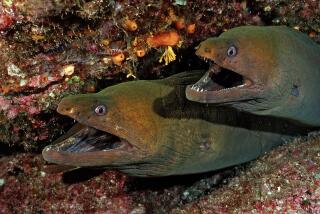Jumbo squid ink-jet into Newport Beach
Braedon Flynn got the text Friday from his friend Ryan Lawlor: Jumbo squid had invaded the waters off Newport Beach.
Flynn, a Newport Beach native who had been around fishing all his life, had never encountered the oversized creatures. Lawlor, who’d tangled with them a few years ago off San Diego, promised to call Flynn if the squid ever made it to Newport Beach.
So Flynn and Lawlor grabbed fishing rods Saturday night and jumped on a private boat with a third buddy, trailing a commercial vessel that was using sonar to locate the squid population.
Flynn said he had one thing in mind: calamari steak. On moonlit waters two miles off the coast, the trio caught six Humboldt squid, each between 4 and 5 feet long. A commercial-market squid is about the size of a human hand.
“It was a good fight,” Flynn, 28, said of his ink-stained prizes, now sitting chopped up in a freezer. “They’re really heavy, they’re going against you -- your rods are practically bent to the water.”
The invasion of the jumbo squid in Orange County -- not to be confused with the exceedingly rare and much larger giant squid -- has prompted fishing-boat operators to add nighttime voyages.
The operators have reported that since Thursday evening, anglers have landed more than 1,000 of the squid.
“That is a very, very small sample of the amount of squid that is out there now,” said Eddie Kisfaludy, a marine biology collector at the Scripps Institution of Oceanography. The creatures have been hanging around San Diego shores for more than a month.
Researchers say the squid inhabit the eastern Pacific Ocean, making appearances from Chile to as far north as Alaska. But their stops along the coastline have been much more common over the last decade, said William Gilly, professor of biology at Stanford University’s Hopkins Marine Station. Scientists at the Monterey Bay Aquarium Research Institute first spotted the squid during the El Nino storms of the late 1980s.
“They’ve been periodic visitors along the coast of Central and Northern California a long time,” said Bruce Robison, a senior scientist at the institute. “They’d show up as far back as the ‘30s.”
After El Nino storms in the late 1990s, the institute began to document the squid’s life cycle. But the squid disappeared for a few years, until they moved into Monterey Bay on a permanent basis in 2002, Gilly said.
Scientists say the squid inhabit an oxygen-poor zone that tends to start about 1,000 feet below the water’s surface during the day, feeding off krill and fish.
Because of climate change, that zone is rising into shallower waters, bringing the squid closer to the surface, Kisfaludy said. Overfishing may have also squeezed out such large sea creatures as tuna and sharks, which both prey on the squid and compete with them for food, said Hopkins technician Ashley Booth.
Scientists have begun worrying about the invasive nature of the Humboldt squid. Robison points to hake, the most abundant commercial groundfish species off the West Coast.
“Hake has been clobbered, apparently, by these squid,” Robison said. “Its decline exactly matches [the squid’s] rise.”
The squid being caught off Newport Beach tend to weigh from 20 to 40 pounds and make for good eating, anglers said.
“There’s a certain novelty to catching your own calamari,” said Lawlor, 20. “But it’s best to tenderize the meat. It’s a different quality, but it’s good enough.”
Landing the hefty catch can prove to be a messy challenge.
Once on the boat, “they’re trying to crawl around and blow ink all over everybody,” said Robert Woodbury, manager of Newport Landing Sportfishing.
But that is part of the fun, he added.
“When they’re lifted out of the water . . . they become a giant squirt gun,” Woodbury said. “Chances are you’re gonna take a faceful or a chestful of water -- and probably ink -- when you pull them out.”
--



